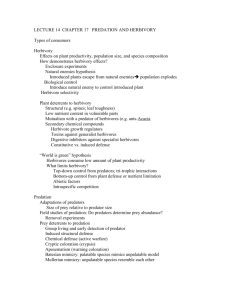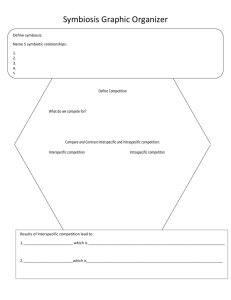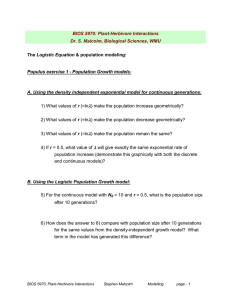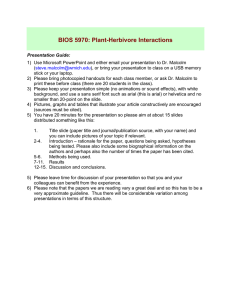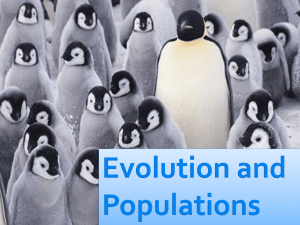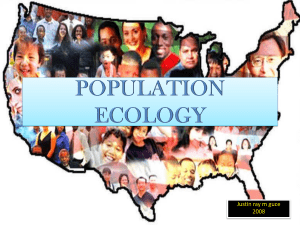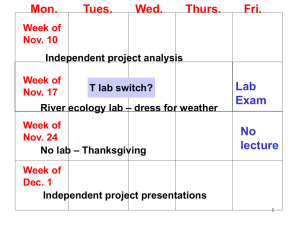BIOS 5970: Plant-Herbivore Interactions • Week 13.
advertisement
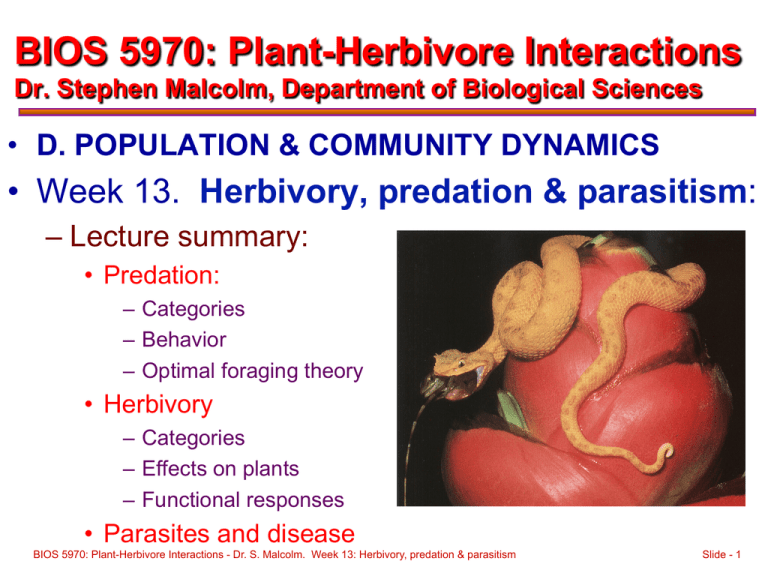
BIOS 5970: Plant-Herbivore Interactions Dr. Stephen Malcolm, Department of Biological Sciences • D. POPULATION & COMMUNITY DYNAMICS • Week 13. Herbivory, predation & parasitism: – Lecture summary: • Predation: – Categories – Behavior – Optimal foraging theory • Herbivory – Categories – Effects on plants – Functional responses • Parasites and disease BIOS 5970: Plant-Herbivore Interactions - Dr. S. Malcolm. Week 13: Herbivory, predation & parasitism Slide - 1 2. Predation: • “Predation” usually includes considerations of parasitism and herbivory. • Like parasitism and herbivory it is a description of the interaction between predator foraging behavior and prey defense – Literature reflects strong emphasis on predator foraging behavior and prey-predator dynamics. – Defense is mostly relegated to the realms of natural history description. BIOS 5970: Plant-Herbivore Interactions - Dr. S. Malcolm. Week 13: Herbivory, predation & parasitism Slide - 2 3. Predator foraging behavior: • Description of: – Where they feed. – What they feed on. – How they are influenced by other predators. – How they are influenced by prey density. BIOS 5970: Plant-Herbivore Interactions - Dr. S. Malcolm. Week 13: Herbivory, predation & parasitism Slide - 3 4. Categories of Predation: • Begon, Harper & Townsend (1996) use “predation” to consider the following categories of “predator”: – Predators: • Kill and completely consume many prey items during their life. – Parasitoids: • Free-living adult insects that lay eggs in or on their single host ("prey") in which the larva (or larvae) develops into a new free-living adult. • Host is always killed. – Parasites: • Most of their life is spent in close association in or on a single host and usually do not kill the host. – Herbivores: • Most only partially consume individual plants, but they include a range of plant feeders that act like true parasites (e.g. aphids), parasitoids (e.g. fig wasps), predators (e.g. mice and seed beetles). BIOS 5970: Plant-Herbivore Interactions - Dr. S. Malcolm. Week 13: Herbivory, predation & parasitism Slide - 4 5. Diet composition and food preference: • Predators can be: – Monophagous: • Single prey type and have a large impact on prey population dynamics. – Oligophagous: • Few prey types – Polyphagous: • Many prey types and probably have little impact on the population dynamics of any one species. BIOS 5970: Plant-Herbivore Interactions - Dr. S. Malcolm. Week 13: Herbivory, predation & parasitism Slide - 5 6. Prey choice and profitability: • Within basic diet breadths predators choose more profitable prey preferentially (Fig. 9.1). BIOS 5970: Plant-Herbivore Interactions - Dr. S. Malcolm. Week 13: Herbivory, predation & parasitism Slide - 6 7. Herbivore choice (Table 9.1): BIOS 5970: Plant-Herbivore Interactions - Dr. S. Malcolm. Week 13: Herbivory, predation & parasitism Slide - 7 8. Assessment of profitability: • Food can be assessed by predators as either: – Ranked food resources: • Most valuable or “perfectly substitutable” – Balanced food resources: • Integral or “complementary” • Usually necessary to balance required nutrients that may be absent from high ranked foods. BIOS 5970: Plant-Herbivore Interactions - Dr. S. Malcolm. Week 13: Herbivory, predation & parasitism Slide - 8 9. Switching: • Predators can also “switch” their food preference. • Through learned abilities to handle prey more profitably: – More efficient balance among, search, pursuit, and handling behaviors before consumption. – May be facilitated by specific “search images”. – Such changes in diet may also be seasonal or on shorter time scales that may be associated with the induction of physiologies better suited to exploiting the food resource. BIOS 5970: Plant-Herbivore Interactions - Dr. S. Malcolm. Week 13: Herbivory, predation & parasitism Slide - 9 10. “Optimal foraging” and diet width: • Why are real diets “narrower” than potential diets? • If energy maximization is the primary criterion that correlates with fitness then optimal foraging theory is useful. • MacArthur & Pianka (1966) initiated the influential optimal foraging theory approach for the description of the evolutionary ecology of predatory behavior based on maximization of the net rate of energy intake: – Net rate of energy in take = gross energy intake energetic costs of obtaining that energy. BIOS 5970: Plant-Herbivore Interactions - Dr. S. Malcolm. Week 13: Herbivory, predation & parasitism Slide - 10 11. Predator costs: • Energy and time costs of: – Searching for prey – Handling prey - includes: • Detection • Pursuit • Acceptance • Subjugation • Consumption & Digestion BIOS 5970: Plant-Herbivore Interactions - Dr. S. Malcolm. Week 13: Herbivory, predation & parasitism Slide - 11 12. Optimal foraging theory: • Aim is to predict the expected foraging “strategy” under specified conditions: – Is it a "tactic" or a "strategy" ? – Generalists: • Have low time search costs but higher costs of handling both unprofitable and profitable prey. – Specialists: • Have high time costs but lower costs of handling profitable prey. BIOS 5970: Plant-Herbivore Interactions - Dr. S. Malcolm. Week 13: Herbivory, predation & parasitism Slide - 12 13. Diet profitability: • MacArthur & Pianka argued that a prey item should be included (and diet width expanded) if it is equal to or more profitable than the average profitability of the present diet. • Thus should eat ith prey if: E E ≥ h (s + h ) i i – Where i is the next most profitable prey item. – E = energy content, h = handling time (therefore E/h = profitability), s = search time BIOS 5970: Plant-Herbivore Interactions - Dr. S. Malcolm. Week 13: Herbivory, predation & parasitism Slide - 13 14. Diet profitability: • handling time < search time = generalists – e.g. foliage gleaning bird guild • Guild is a group of individuals that exploit the same resource in the same way • handling time > search time = specialists – e.g. lions living near prey – Note: handling time includes pursuit time! BIOS 5970: Plant-Herbivore Interactions - Dr. S. Malcolm. Week 13: Herbivory, predation & parasitism Slide - 14 15. Marginal Value Theorem: • Based on work of Charnov (1976) and Parker & Stuart (1976) to predict behavior of optimal forager in patches of food of different profitabilities. • Forager should maximize overall intake of resource (energy) per time spent foraging in habitats with food distributed patchily. • How long should the forager spend in patches of varying profitability? BIOS 5970: Plant-Herbivore Interactions - Dr. S. Malcolm. Week 13: Herbivory, predation & parasitism Slide - 15 16. Marginal Value Theorem Fig. 9.16: BIOS 5970: Plant-Herbivore Interactions - Dr. S. Malcolm. Week 13: Herbivory, predation & parasitism Slide - 16 17. Herbivory: • Problems: Herbivory is sometimes considered as a subset of predation because of 2 ways to classify consumers: – 1. Taxonomic classification: • Carnivores consume animals. • Herbivores consume plants. • Omnivores consume plants and animals. BIOS 5970: Plant-Herbivore Interactions - Dr. S. Malcolm. Week 13: Herbivory, predation & parasitism Slide - 17 18. Herbivory: • 2. Functional classification: – True predators: • Kill and consume prey immediately; kill many prey – Grazers: • Attack many "prey"; rarely lethal; only partially consume – Parasitoids: • Attack single "prey", always lethal, complete consumption – Parasites (micro and macro): • Attack few or single "prey"; rarely lethal; only partially consume – Caveat: modularity is an important consideration (modular versus unitary organisms)! BIOS 5970: Plant-Herbivore Interactions - Dr. S. Malcolm. Week 13: Herbivory, predation & parasitism Slide - 18 19. Basic kinds of herbivores: • • • • • • • • • Grazers - sheep, bison, rabbits and grasshoppers. Browsers - deer, goats and hares. Leaf miners - many insects. Borers - of leaves, stems, trunks, buds, seeds and fruits - many insects. Root feeders - nematodes, insects, mammals. Sap suckers - many insects, birds and mammals. Gallers - many insects, mites, nematodes and bacteria. Vary according to scale of host resources (modularity) and herbivore exploiter… In addition frugivores, seed predators, pollinators, and nectarivores all feed on plant parts. BIOS 5970: Plant-Herbivore Interactions - Dr. S. Malcolm. Week 13: Herbivory, predation & parasitism Slide - 19 20. Herbivore feeding guilds (Fig. 12.7): BIOS 5970: Plant-Herbivore Interactions - Dr. S. Malcolm. Week 13: Herbivory, predation & parasitism Slide - 20 21. Six effects of herbivores on plant distribution and abundance: • 1. Compensation: – Despite some compensation herbivores almost always harm plants (Figs. 8.2 (grass growth) & 8.3 (parsnip flowers). BIOS 5970: Plant-Herbivore Interactions - Dr. S. Malcolm. Week 13: Herbivory, predation & parasitism Slide - 21 22. Six effects of herbivores on plant distribution and abundance: • 2. Enhance negative competitive effects: – Fig. 8.4, 2nd ed. (barley/oats) & 8.7 (beetle on Rumex) BIOS 5970: Plant-Herbivore Interactions - Dr. S. Malcolm. Week 13: Herbivory, predation & parasitism Slide - 22 23. Six effects of herbivores on plant distribution and abundance: • 3. Defense: – Repeated defoliation by herbivores can kill plants or make them more susceptible to death but they can defend: • e.g. Fig 8.4 West's leaf miners and inducible defenses. BIOS 5970: Plant-Herbivore Interactions - Dr. S. Malcolm. Week 13: Herbivory, predation & parasitism Slide - 23 24. Six effects of herbivores on plant distribution and abundance: • 4. Survivorship: – Mature plants are usually not killed: • Although repeated herbivory can increase mortality. – Recruitment can be slowed by herbivores killing seeds or seedlings. – Charles Darwin found 83% mortality. • 5. Growth: – Herbivory can slow or stop plant growth. – Timing is important. – But grasses tend to be resistant to the effects of grazing because the low meristem is unaffected. BIOS 5970: Plant-Herbivore Interactions - Dr. S. Malcolm. Week 13: Herbivory, predation & parasitism Slide - 24 25. Six effects of herbivores on plant distribution and abundance: • 6. Fecundity can be reduced: – Growth related: • Smaller plants produce fewer or less viable seeds. – Plants may flower later: • e.g. can turn annuals into perennials by repeated grazing or mowing (Poa annua). – Herbivores can eat reproductive parts (flowers) directly: • Excluding mutualistic pollen, or nectar, feeding, or exploitative seed predation. BIOS 5970: Plant-Herbivore Interactions - Dr. S. Malcolm. Week 13: Herbivory, predation & parasitism Slide - 25 26. Effects of herbivory on plant populations: • Impact greatest on stressed individuals. • Compensation by unaffected individuals because of reduced intraspecific competition. – Thus herbivory and competition can balance each other out and result in similar densities before & after the event. – Because net recruitment/productivity increase. • Negative effects of herbivory are modified to some extent in modular plants: – Thus compensation is important. • Threshold for compensation is important to consider for repeated harvests or exploitation by natural herbivores: – e.g. locust plagues and herbivore mobility. • Herbivore compensation. BIOS 5970: Plant-Herbivore Interactions - Dr. S. Malcolm. Week 13: Herbivory, predation & parasitism Slide - 26 27. Functional responses of herbivores: • To plant biomass: – Implies satiation at high levels of food availability. • May explain unpredictable masting by trees subject to high levels of herbivory to swamp herbivore recruitment and ensure high seed/ seedling survivorship..… – but should plants also enhance dispersion to reduce the impact of intraspecific competition in these years? BIOS 5970: Plant-Herbivore Interactions - Dr. S. Malcolm. Week 13: Herbivory, predation & parasitism Slide - 27 28. Masting (Figs. 8.11 & 8.12): • Herbivore life histories cannot respond? BIOS 5970: Plant-Herbivore Interactions - Dr. S. Malcolm. Week 13: Herbivory, predation & parasitism Slide - 28 29. Cost of masting: • Masting is expensive for the plant! – Perhaps not as costly though as the impact of severe herbivory! – Temporal scaling of life histories: • Herbivores with short generation times can track resource quantity fluctuations more effectively than herbivores with long generation times. BIOS 5970: Plant-Herbivore Interactions - Dr. S. Malcolm. Week 13: Herbivory, predation & parasitism Slide - 29 30. The effect of grazing herbivores on community structure: • Herbivory, predation, disease and parasitism, competition, earthquakes, fire, rain, wind, temperature etc. can all disturb communities (Fig. 21.1). BIOS 5970: Plant-Herbivore Interactions - Dr. S. Malcolm. Week 13: Herbivory, predation & parasitism Slide - 30 31. Disturbance: • “any relatively discrete event in time that removes organisms or otherwise disrupts the community by influencing the availability of space or food resources, or by changing the physical environment.” • “A general consequence is likely to be the opening up of space, or freeing up of resources, that can be taken over by new individuals.” – For example, a predator, or herbivore, or lawn mower, or a strong wave, or a strong wind can open gaps in communities. BIOS 5970: Plant-Herbivore Interactions - Dr. S. Malcolm. Week 13: Herbivory, predation & parasitism Slide - 31 32. Intermediate grazing and exploitermediated coexistence: • Grazing by rabbits can strongly influence plant community structure. • Intermediate grazing promotes most diversity through influence on competition: – “exploiter-mediated coexistence” (Fig. 21.2.). BIOS 5970: Plant-Herbivore Interactions - Dr. S. Malcolm. Week 13: Herbivory, predation & parasitism Slide - 32 33. The effects of parasites and disease: • These exploiters can also affect other interactions and facilitate coexistence of species as in Fig. 21.4. BIOS 5970: Plant-Herbivore Interactions - Dr. S. Malcolm. Week 13: Herbivory, predation & parasitism Slide - 33 34. Effects of disease on community structure: • Strongly negative effects on communities can also occur for highly pathogenic invading diseases such as malaria and bird pox in Hawaii which may have exterminated 50% of the endemic bird species. • Also the destruction of chestnut and elm forests in North America by introduced pathogens. • These effects are also likely to be frequency dependent: – Influenced by the frequency of encounter in high density populations. BIOS 5970: Plant-Herbivore Interactions - Dr. S. Malcolm. Week 13: Herbivory, predation & parasitism Slide - 34
